微观经济学试题
微观经济学考试题及答案详解

微观经济学考试题及答案详解一、选择题1. 需求定律表明,其他条件不变时,商品的价格上升,其需求量将:A. 上升B. 下降C. 不变D. 不确定答案:B解析:需求定律是微观经济学中的一个基本法则,它指出在其他条件不变的情况下,商品的价格越高,消费者对该商品的需求量越低。
2. 完全竞争市场的特点不包括:A. 市场上有大量的买家和卖家B. 产品是同质的C. 市场信息完全透明D. 存在市场壁垒答案:D解析:完全竞争市场的特点包括市场上有大量的买家和卖家,产品是同质的,市场信息完全透明,不存在市场壁垒。
二、判断题1. 在垄断市场中,垄断者可以通过限制产量来提高价格。
()答案:√解析:垄断市场中,由于垄断者控制了市场的供应,他们可以通过限制产量来创造稀缺性,从而提高产品的价格。
2. 边际效用递减意味着消费者对商品的需求是无限的。
()答案:×解析:边际效用递减原理指的是随着消费者消费某一商品数量的增加,每增加一单位商品带来的额外满足感逐渐减少,但并不意味着消费者对商品的需求是无限的。
三、简答题1. 什么是边际成本和平均成本?它们之间的关系是什么?答案:边际成本是指生产额外一单位产品所增加的成本。
平均成本是指生产一定数量产品的平均成本,即总成本除以生产的产品数量。
在生产过程中,边际成本与平均成本的关系可以通过U形曲线来表示。
当边际成本低于平均成本时,平均成本下降;当边际成本高于平均成本时,平均成本上升。
2. 解释什么是消费者剩余,并给出一个例子。
答案:消费者剩余是指消费者愿意支付的价格与他们实际支付的价格之间的差额。
它反映了消费者从购买商品或服务中获得的额外满足感。
例如,如果一个消费者愿意为一杯咖啡支付5元,但实际上只支付了3元,那么消费者剩余就是2元。
四、计算题1. 假设一个完全竞争的厂商面临以下成本函数:TC = 0.5Q^2 - 4Q + 100,其中Q是产量,TC是总成本。
计算当产量为10时的边际成本。
微观经济学测试题及答案

第一章导论一、单项选择题1.经济学产生的原因是()。
A. 生产的需要B. 欲望满足的需要C. 稀缺性的存在与选择的必要D. 选择的需要2.经济学的研究对象是()。
A. 资源配置B. 资源配置和资源利用C. 经济体制D. 资源利用3.微观经济学的中心是()。
A. 价格决定B. 产量决定C. 成本决定D. 利润决定4.( )不是宏观经济学的内容A. 收入决定B. 物价水平C. 经济增长D. 厂商均衡5.经济学的研究方法包括( )。
A. 经济模型B. 静态分析、比较静态和动态分析C. 局部均衡分析与一般均衡分析D. A、B、C二、名词解释1.稀缺性2.选择3.微观经济学4.宏观经济学5.经济学6.实证经济学7.规范经济学8.经济模型三、简答题1. 为什么说稀缺性的存在与选择的必要引起了经济学的产生?2. 为什么经济学的研究对象是经济资源的合理配置和充分利用问题?3. 微观经济学的研究内容有哪些?4. 宏观经济学的研究内容有哪些?5. 西方经济学的假定前提有哪些?四、论述题1.用生产可能性边界说明经济学既要研究资源配置问题又要研究资源利用问题。
习题解答一、单项选择题1. C2. B3. A4. D5. D第二章需求和供给理论一、单项选择1.需求曲线上任意一点对应的价格是()。
A. 均衡价格B. 市场价格C. 需求价格D. 最低价格2.在其他条件不变的情况下,消费者收入增加将导致()。
A. 需求量增加B. 需求增加C. 需求量减少D. 需求减少3.下列因素中不能导致需求曲线移动的因素是()。
A. 相关商品的价格不变B. 消费者的价格预期C. 消费者的收入水平D. 商品自身的价格4.两种互补商品中的一种价格下降将导致另一种商品的()上升。
A. 需求量B. 需求C. 价格D. 均衡价格5.一种商品的价格下降会导致其替代商品的需求曲线()。
A. 向左方移动B. 向右方移动C. 不变D. 以上三种情况都有可能6.如果一条线性需求曲线与一条非线性需求曲线相切,则切点处两条需求曲线的价格点弹性系数( )。
完整版微观经济学试题库(带答案).doc
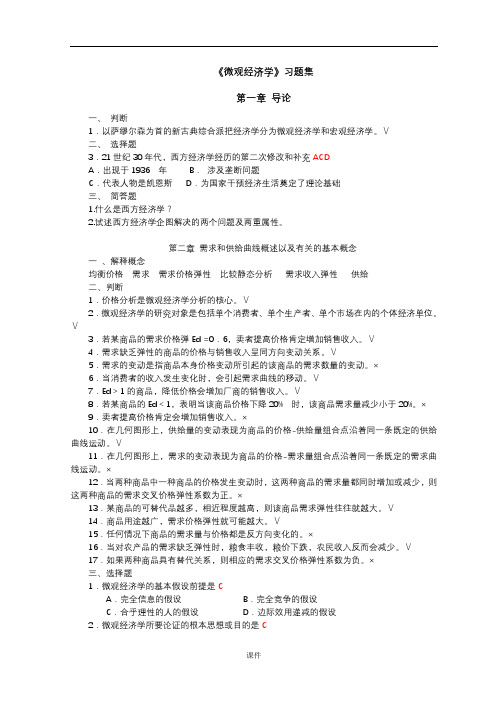
《微观经济学》习题集第一章导论一、判断1.以萨缪尔森为首的新古典综合派把经济学分为微观经济学和宏观经济学。
∨二、选择题3.21世纪30年代,西方经济学经历的第二次修改和补充ACDA.出现于1936 年B.涉及垄断问题C.代表人物是凯恩斯D.为国家干预经济生活奠定了理论基础三、简答题1.什么是西方经济学?2.试述西方经济学企图解决的两个问题及两重属性。
第二章需求和供给曲线概述以及有关的基本概念一、解释概念均衡价格需求需求价格弹性比较静态分析需求收入弹性供给二、判断1.价格分析是微观经济学分析的核心。
∨2.微观经济学的研究对象是包括单个消费者、单个生产者、单个市场在内的个体经济单位。
∨3.若某商品的需求价格弹Ed =0.6,卖者提高价格肯定增加销售收入。
∨4.需求缺乏弹性的商品的价格与销售收入呈同方向变动关系。
∨5.需求的变动是指商品本身价格变动所引起的该商品的需求数量的变动。
×6.当消费者的收入发生变化时,会引起需求曲线的移动。
∨7.Ed>1的商品,降低价格会增加厂商的销售收入。
∨8.若某商品的Ed<1,表明当该商品价格下降20% 时,该商品需求量减少小于20%。
×9.卖者提高价格肯定会增加销售收入。
×10.在几何图形上,供给量的变动表现为商品的价格-供给量组合点沿着同一条既定的供给曲线运动。
∨11.在几何图形上,需求的变动表现为商品的价格-需求量组合点沿着同一条既定的需求曲线运动。
×12.当两种商品中一种商品的价格发生变动时,这两种商品的需求量都同时增加或减少,则这两种商品的需求交叉价格弹性系数为正。
×13.某商品的可替代品越多,相近程度越高,则该商品需求弹性往往就越大。
∨14.商品用途越广,需求价格弹性就可能越大。
∨15.任何情况下商品的需求量与价格都是反方向变化的。
×16.当对农产品的需求缺乏弹性时,粮食丰收,粮价下跌,农民收入反而会减少。
《微观经济学》期末测试题及答案

《微观经济学》期末测试题及答案第一套题一、名词解释:1. 需求:在一定的时间和价格条件下,消费者愿意并且能够购买的商品或服务的数量。
2. 供给:在一定的时间和价格条件下,生产者愿意并且能够提供的商品或服务的数量。
3. 均衡价格:在市场上,需求量和供给量相等时的价格。
4. 边际效用:消费者从消费最后一单位商品或服务中获得的额外满足度。
5. 生产可能性边界:在一定的资源和技术条件下,一个经济体所能生产的各种商品的最大组合。
二、填空题:1. 在需求曲线上,价格与需求量的关系是______。
(反向关系)2. 当边际成本大于边际收益时,企业应该______产量。
(减少)3. 消费者剩余是指消费者的______超过其实际支付的价格部分。
(意愿支付)4. 在完全竞争市场中,企业的短期供给曲线是______曲线在平均可变成本之上的部分。
(边际成本)5. _____是市场经济中最基本的价格决定机制。
(供求机制)三、单项选择题:1. 下列哪种情况会导致需求曲线向右移动?(B)A. 商品价格上升B. 消费者收入增加C. 替代品价格下降D. 商品的生产成本增加2. 当市场价格低于均衡价格时,市场上会出现(C)。
A. 供大于求B. 供求平衡C. 供不应求D. 不确定3. 在生产者理论中,当边际收益小于边际成本时,生产者应(A)。
A. 减少产量B. 增加产量C. 保持产量不变D. 关闭生产4. 市场经济中,资源配置的主要方式是通过(D)。
A. 政府计划B. 行业协会规定C. 企业自主决策D. 价格机制5. 下列哪种市场结构中,企业具有最大的定价能力?(D)A. 完全竞争市场B. 垄断竞争市场C. 寡头垄断市场D. 完全垄断市场四、多项选择题:1. 下列哪些因素会影响需求?(ABCD)A. 消费者收入B. 商品价格C. 相关商品的价格D. 消费者的偏好2. 下列哪些情况下,企业的供给曲线会向右移动?(AC)A. 生产技术进步B. 生产成本增加C. 原材料价格下降D. 政府提高税收3. 下列关于边际效用的说法正确的是?(BC)A. 边际效用总是递增的B. 边际效用可能为负C. 总效用达到最大时,边际效用为零D. 边际效用不能用于衡量消费者的总满足度4. 市场失灵的原因可能包括?(ABCD)A. 公共物品的存在B. 外部性的影响C. 垄断的存在D. 信息不对称5. 下列哪些市场结构中,企业可以设定价格?(AD)A. 完全垄断市场B. 完全竞争市场C. 垄断竞争市场D. 寡头垄断市场五、判断题:1. 如果一种商品的需求价格弹性大于1,那么该商品是必需品。
微观经济学mooc测试题及答案

微观经济学mooc测试题及答案一、选择题(每题2分,共10分)1. 微观经济学主要研究的是:A. 宏观经济现象B. 个体经济单位的行为C. 政府经济政策D. 国际经济关系答案:B2. 需求曲线通常表示为:A. 水平线B. 垂直线C. 下降线D. 上升线答案:C3. 边际效用递减原理指的是:A. 随着消费的增加,总效用增加B. 随着消费的增加,边际效用增加C. 随着消费的增加,边际效用减少D. 随着消费的增加,总效用减少答案:C4. 完全竞争市场的特征不包括:A. 产品同质化B. 买卖双方数量众多C. 买卖双方对价格有影响D. 没有进入和退出障碍答案:C5. 机会成本是指:A. 放弃的最低价值B. 放弃的最高价值C. 放弃的中间价值D. 放弃的任何价值答案:A二、判断题(每题1分,共5分)1. 价格弹性是衡量需求量对价格变化的敏感程度的指标。
(对)2. 边际成本在完全竞争市场中等于平均成本。
(对)3. 垄断市场下,企业的利润最大化产量是边际成本等于边际收益时的产量。
(对)4. 公共物品具有非排他性和非竞争性。
(对)5. 外部性是指个体经济单位在生产或消费活动中对第三方产生的非市场影响。
(对)三、简答题(每题5分,共10分)1. 什么是价格歧视?请举例说明。
答案:价格歧视是指同一产品或服务对不同消费者或不同购买数量收取不同价格的行为。
例如,电影院对学生和成人收取不同的票价。
2. 请解释什么是消费者剩余,并给出一个例子。
答案:消费者剩余是指消费者愿意支付的价格与实际支付价格之间的差额。
例如,如果一个人愿意为一杯咖啡支付5元,但实际上只支付了3元,那么他的消费者剩余就是2元。
四、计算题(每题10分,共20分)1. 假设某商品的供给函数为Qs = 10P,需求函数为Qd = 50 - 2P,求市场均衡价格和均衡数量。
答案:将供给函数和需求函数相等,即10P = 50 - 2P,解得P = 4。
将P代入任一函数求得Q,Q = 50 - 2*4 = 42。
微观经济学试题及答案(精选5份)
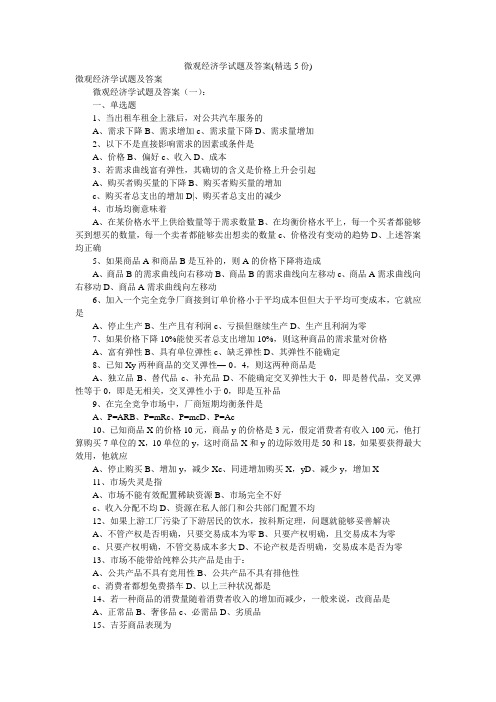
微观经济学试题及答案(精选5份)微观经济学试题及答案微观经济学试题及答案(一):一、单选题1、当出租车租金上涨后,对公共汽车服务的A、需求下降B、需求增加c、需求量下降D、需求量增加2、以下不是直接影响需求的因素或条件是A、价格B、偏好c、收入D、成本3、若需求曲线富有弹性,其确切的含义是价格上升会引起A、购买者购买量的下降B、购买者购买量的增加c、购买者总支出的增加D|、购买者总支出的减少4、市场均衡意味着A、在某价格水平上供给数量等于需求数量B、在均衡价格水平上,每一个买者都能够买到想买的数量,每一个卖者都能够卖出想卖的数量c、价格没有变动的趋势D、上述答案均正确5、如果商品A和商品B是互补的,则A的价格下降将造成A、商品B的需求曲线向右移动B、商品B的需求曲线向左移动c、商品A需求曲线向右移动D、商品A需求曲线向左移动6、加入一个完全竞争厂商接到订单价格小于平均成本但但大于平均可变成本,它就应是A、停止生产B、生产且有利润c、亏损但继续生产D、生产且利润为零7、如果价格下降10%能使买者总支出增加10%,则这种商品的需求量对价格A、富有弹性B、具有单位弹性c、缺乏弹性D、其弹性不能确定8、已知Xy两种商品的交叉弹性—-0。
4,则这两种商品是A、独立品B、替代品c、补充品D、不能确定交叉弹性大于0,即是替代品,交叉弹性等于0,即是无相关,交叉弹性小于0,即是互补品9、在完全竞争市场中,厂商短期均衡条件是A、P=ARB、P=mRc、P=mcD、P=Ac10、已知商品X的价格10元,商品y的价格是3元,假定消费者有收入100元,他打算购买7单位的X,10单位的y,这时商品X和y的边际效用是50和18,如果要获得最大效用,他就应A、停止购买B、增加y,减少Xc、同进增加购买X,yD、减少y,增加X11、市场失灵是指A、市场不能有效配置稀缺资源B、市场完全不好c、收入分配不均D、资源在私人部门和公共部门配置不均12、如果上游工厂污染了下游居民的饮水,按科斯定理,问题就能够妥善解决A、不管产权是否明确,只要交易成本为零B、只要产权明确,且交易成本为零c、只要产权明确,不管交易成本多大D、不论产权是否明确,交易成本是否为零13、市场不能带给纯粹公共产品是由于:A、公共产品不具有竞用性B、公共产品不具有排他性c、消费者都想免费搭车D、以上三种状况都是14、若一种商品的消费量随着消费者收入的增加而减少,一般来说,改商品是A、正常品B、奢侈品c、必需品D、劣质品15、吉芬商品表现为A、需求收入弹性和需求价格弹性都是正值B、需求收入弹性为负,需求价格弹性为正c、需求收入弹性为正,需求价格弹性为负D、需求收入弹性和需求价格弹性都是负值二、作图分析说明题1、作图说明赋税是如何造成经济剩余的无谓损失2、作图说明利率提高是何增加或是减少家庭储蓄的两种图型,并做必须的分析三、计算题1、从甲地到乙地汽车原价为10元,火车的乘客为12万,当汽车的票价由原先的10元减至8。
微观经济学试题库[含答案解析]
![微观经济学试题库[含答案解析]](https://img.taocdn.com/s3/m/cc3c7246af1ffc4ffe47ac34.png)
第一章引论一、单选题(70题)1. 下列哪一种资源是最不具有稀缺性的?)A.医生;B.苹果;C.铁矿石;D.空气;2. 下列中的哪一个问题是最有可能被微观经济学家所研究的?)A. 一般物价的膨胀;B. 整个经济中的失业;C. 总产出的增长率;D. 汽车行业中的劳动就业3. 下列中的哪一个属于规范经济问题? ()A. 通货膨胀和失业是由什么引起的?B. 政府应该雇用所有失业的工人吗?C. 消费者如何对较低的价格做出反应?D. 收入与储蓄之间的关系是什么?4. 经济学有时被称作社会科学的皇后,这是因为:(A.它强调经济增长和经济发展;B. 几乎所有的学生都必须学习经济学;C. 它的边际分析方法广泛应用于其他学科;D. 规范经济学和实证经济学的区别。
5. 经济学家的理性行为假定:()A.仅仅在其提供有效预测的限度内才是有用的。
B.导致错误的理论,因为人们并非总是理性的。
C.只有当所有人都是理性的,才是有用的。
D.不管人们是否为理性的,都是有效的。
6. 微观经济学研究(),宏观经济学研究()。
A.现实的经济问题,抽象的经济理论;B.个量经济,总量经济C.理性行为,非理性行为;D.企业行为,政府行为7.经济学可定义为()。
A.政府对市场制度的干预 B.企业赚取利润的活动C.研究稀缺资源如何有效配置的问题D.个人的生财之道8.“资源是稀缺的”是指()A.资源是不可再生的 B.资源必须留给下一代C.资源终将被耗费殆尽D.相对于需求而言,资源总是不足的.9.失业问题如果反映在生产可能性曲线图上,可记为()A.生产可能性曲线内的一点 B.生产可能性曲线上的一点C.生产可能性曲线以外的一点D.不在该平面直角坐标系上.10.下列哪一项会导致一国生产可能性曲线的外移?()A.股市持续走强 B.通货膨胀C.有用资源被发掘或技术进步D.消费品生产增加,资本品生产下降. 11.一个经济体系必须作出的基本选择是()。
A.生产什么,生产多少 B.如何生产 C.为谁生产 D.以上都包括12.计划经济体制解决资源配置问题的方式有()。
微观经济学考试试题及答案解析
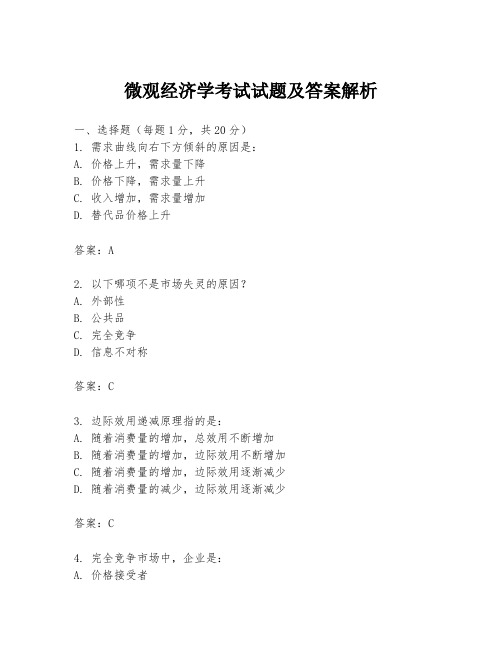
微观经济学考试试题及答案解析一、选择题(每题1分,共20分)1. 需求曲线向右下方倾斜的原因是:A. 价格上升,需求量下降B. 价格下降,需求量上升C. 收入增加,需求量增加D. 替代品价格上升答案:A2. 以下哪项不是市场失灵的原因?A. 外部性B. 公共品C. 完全竞争D. 信息不对称答案:C3. 边际效用递减原理指的是:A. 随着消费量的增加,总效用不断增加B. 随着消费量的增加,边际效用不断增加C. 随着消费量的增加,边际效用逐渐减少D. 随着消费量的减少,边际效用逐渐减少答案:C4. 完全竞争市场中,企业是:A. 价格接受者B. 价格制定者C. 垄断者D. 寡头竞争者答案:A5. 以下哪项不是生产要素?A. 劳动B. 土地C. 资本D. 利润答案:D...(此处省略15题,以保持篇幅适中)二、判断题(每题1分,共10分)1. 价格弹性是衡量需求量对价格变化的敏感程度的指标。
(正确)2. 边际成本在完全竞争市场中等于平均成本时,企业获得正常利润。
(正确)3. 垄断市场中,价格总是高于边际成本。
(错误)4. 公共品具有非排他性和非竞争性。
(正确)5. 消费者剩余是指消费者支付的价格与他们愿意支付的最高价格之间的差额。
(正确)...(此处省略5题)三、简答题(每题5分,共20分)1. 简述边际成本与平均成本的关系。
答:边际成本是指生产额外一单位产品所增加的成本,而平均成本是总成本除以总产量。
在生产过程中,边际成本与平均成本的关系取决于边际成本曲线与平均成本曲线的相对位置。
如果边际成本低于平均成本,那么生产额外单位产品会降低平均成本;如果边际成本高于平均成本,那么生产额外单位产品会提高平均成本。
2. 解释完全竞争市场的四个特征。
答:完全竞争市场具有以下四个特征:一是市场上存在大量的买家和卖家,没有单个买家或卖家能够影响市场价格;二是产品是同质的,即所有产品之间没有质量差异;三是市场信息完全透明,所有参与者都能够获得市场信息;四是进入和退出市场没有壁垒,企业可以自由进入或退出市场。
微观经济学试题及答案解析
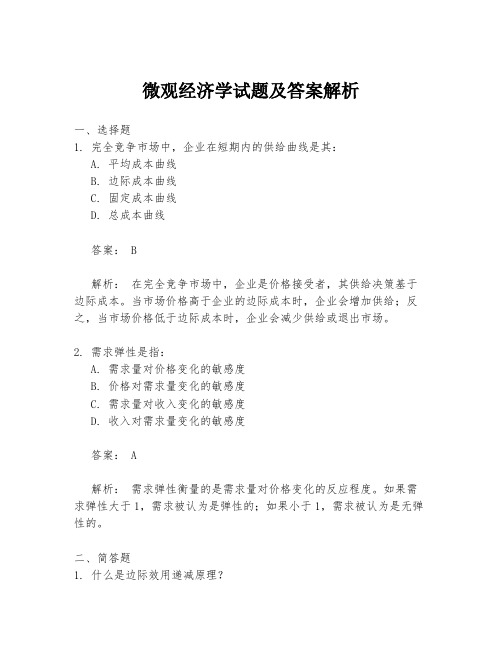
微观经济学试题及答案解析一、选择题1. 完全竞争市场中,企业在短期内的供给曲线是其:A. 平均成本曲线B. 边际成本曲线C. 固定成本曲线D. 总成本曲线答案: B解析:在完全竞争市场中,企业是价格接受者,其供给决策基于边际成本。
当市场价格高于企业的边际成本时,企业会增加供给;反之,当市场价格低于边际成本时,企业会减少供给或退出市场。
2. 需求弹性是指:A. 需求量对价格变化的敏感度B. 价格对需求量变化的敏感度C. 需求量对收入变化的敏感度D. 收入对需求量变化的敏感度答案: A解析:需求弹性衡量的是需求量对价格变化的反应程度。
如果需求弹性大于1,需求被认为是弹性的;如果小于1,需求被认为是无弹性的。
二、简答题1. 什么是边际效用递减原理?答案:边际效用递减原理指的是随着消费者消费某一商品的数量增加,每增加一个单位商品所带来的额外满足感(边际效用)逐渐减少的现象。
2. 什么是价格歧视?请简述其类型。
答案:价格歧视是指同一商品或服务对不同消费者或在不同时间、地点以不同价格出售的行为。
其类型包括:一级价格歧视(对每个消费者都收取其愿意支付的最高价格)、二级价格歧视(对不同数量的购买收取不同价格)、三级价格歧视(对不同市场或消费者群体收取不同价格)。
三、计算题1. 假设一个完全竞争企业的总成本函数为TC = 0.5Q^2 + 2Q + 10,其中Q是产量。
求该企业在市场价格P=5时的最优产量。
答案:首先,计算边际成本(MC):MC = d(TC)/dQ = Q + 2。
当市场价格P=5时,企业将生产到MC=P,即5=Q+2,解得Q=3。
解析:企业在市场价格等于其边际成本时达到最优产量,因为此时企业无法通过增加或减少产量来增加利润。
四、论述题1. 论述市场失灵的原因及其对经济的影响。
答案:市场失灵是指市场机制不能有效地分配资源,导致资源配置效率低下。
原因包括外部性、公共品、信息不对称、垄断等。
市场失灵会导致资源浪费、收入分配不公、消费者和生产者剩余减少等经济问题。
微观经济学考试试题

微观经济学考试试题一、选择题(每题2分,共20分)1. 需求法则表明,其他条件不变时,商品价格上升,需求数量:A. 增加B. 减少C. 不变D. 先增加后减少2. 完全竞争市场中,生产者是价格的:A. 制定者B. 接受者C. 影响者D. 观察者3. 边际效用递减原理意味着,随着消费者消费某一商品数量的增加,每增加一单位商品带来的额外满足感:A. 增加B. 减少C. 不变D. 先增加后减少4. 机会成本是指:A. 放弃的最高价值B. 放弃的最低价值C. 放弃的任何价值D. 放弃的无价值5. 以下哪项不是生产要素?A. 劳动B. 土地C. 资本D. 产品二、判断题(每题1分,共10分)1. 价格弹性是衡量需求对价格变化的敏感程度的指标。
()2. 边际成本曲线与平均成本曲线的交点,是平均成本的最低点。
()3. 垄断市场中,企业可以通过限制产量来提高价格。
()4. 消费者剩余是指消费者愿意支付的最高价格与市场价格之间的差额。
()5. 完全竞争市场假设生产者是价格的接受者,因此价格是固定的。
()三、简答题(每题10分,共20分)1. 解释边际成本与平均成本的关系,并说明为什么企业在决策时需要考虑这些成本。
2. 描述完全竞争市场的特征,并解释为什么在现实世界中很难找到完全竞争市场的例子。
四、计算题(每题15分,共30分)1. 假设某企业生产Q单位产品时的总成本函数为TC(Q) = 0.5Q^2 -10Q + 100。
计算当Q=10时的边际成本、平均成本和总成本。
并说明在这种情况下,企业是否会增加产量?2. 一个消费者面临两种商品X和Y的价格分别为Px=2和Py=3,消费者的收入为I=120。
假设消费者对商品X和Y的边际替代率(MRS)为2/3。
如果消费者将全部收入用于购买这两种商品,计算消费者购买这两种商品的数量,并说明消费者剩余。
五、论述题(共20分)1. 讨论市场失灵的原因,并举例说明政府如何通过政策干预来纠正市场失灵。
微观经济学测试题及答案
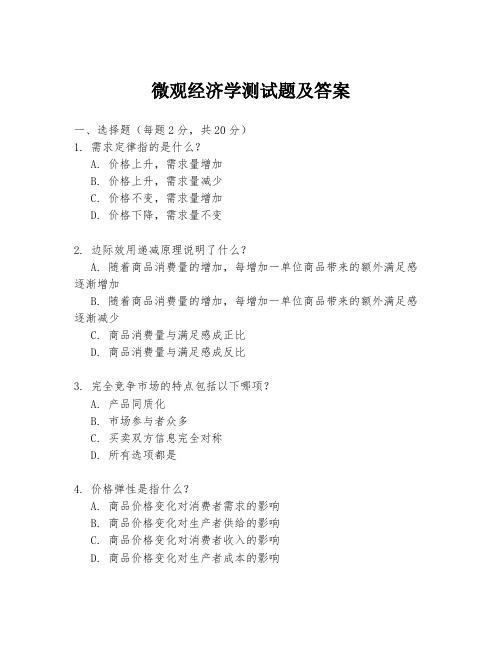
微观经济学测试题及答案一、选择题(每题2分,共20分)1. 需求定律指的是什么?A. 价格上升,需求量增加B. 价格上升,需求量减少C. 价格不变,需求量增加D. 价格下降,需求量不变2. 边际效用递减原理说明了什么?A. 随着商品消费量的增加,每增加一单位商品带来的额外满足感逐渐增加B. 随着商品消费量的增加,每增加一单位商品带来的额外满足感逐渐减少C. 商品消费量与满足感成正比D. 商品消费量与满足感成反比3. 完全竞争市场的特点包括以下哪项?A. 产品同质化B. 市场参与者众多C. 买卖双方信息完全对称D. 所有选项都是4. 价格弹性是指什么?A. 商品价格变化对消费者需求的影响B. 商品价格变化对生产者供给的影响C. 商品价格变化对消费者收入的影响D. 商品价格变化对生产者成本的影响5. 以下哪项不是市场失灵的原因?A. 公共物品B. 外部性C. 垄断D. 消费者偏好6. 机会成本是指什么?A. 做出选择时放弃的最低价值选项B. 做出选择时放弃的最高价值选项C. 做出选择时放弃的所有选项的总价值D. 做出选择时放弃的最低成本选项7. 消费者剩余是指什么?A. 消费者支付的价格与商品价值之间的差额B. 消费者支付的价格与商品成本之间的差额C. 消费者支付的价格与商品供给价格之间的差额D. 消费者支付的价格与商品边际成本之间的差额8. 短期成本与长期成本的区别是什么?A. 短期成本包括固定成本和可变成本,长期成本只包括可变成本B. 短期成本只包括固定成本,长期成本包括固定成本和可变成本C. 短期成本只包括可变成本,长期成本包括固定成本和可变成本D. 短期成本和长期成本没有区别9. 完全垄断市场的特征是什么?A. 市场上只有一个卖者B. 产品具有独特性C. 进入市场存在障碍D. 所有选项都是10. 价格歧视是指什么?A. 根据消费者的支付意愿不同,对同一商品或服务收取不同的价格B. 根据消费者的收入水平不同,对同一商品或服务收取不同的价格C. 根据消费者的年龄不同,对同一商品或服务收取不同的价格D. 根据消费者的职业不同,对同一商品或服务收取不同的价格二、简答题(每题10分,共20分)1. 请简述边际成本和平均成本的区别及其在企业决策中的作用。
微观经济学_试题及答案

一、选择题:(每题1分,共20分)1.一种商品当其供给增长时,供给者的总收益反而下降。
下列哪项是对该商品的正确判断:()A.这是一种优质品 B.这是一种劣质品C.它富有需求的价格弹性 D.它缺乏需求的价格弹性2.下列哪一种情况会引起对汉堡包的需求增加?()A.一场新的汉堡包热 B.人口减少了C.作为互补品的炸薯条的价格上升了D.消费者收入减少了3.假定某种物品价格从5.5元上升为6.5元,需求量从12500单位减少为11500单位。
在这段需求曲线范围内,需求价格弹性系数的值为:()A.1.0 B.2.0 C.0.5 D.204.总效用曲线达到顶点时:()A.边际效用最大 B.边际效用为零C.边际效用为正值 D.边际效用为负值5.在从原点出发的射线与TC相切的产量上,必有()A. AC值最小;B. AC=MC;C. MC曲线处于上升阶段;D.上述各点都对6.长期平均成本曲线成U型的原因为:()A. 要素报酬先递增后递减B. 要素报酬先递减后递增C. 规模报酬先递增后递减D. 规模报酬先递减后递增7.完全垄断厂商在短期内:()A.可能盈亏相抵 B.可能有超额利润C.可能有亏损 D.以上三种可能性都有8.卡特尔制定统一价格的原则是:()A.使整个卡特尔的产量最大B.使整个卡特尔的利润最大C.使整个卡特尔中各厂商保持稳定性 D.使整个卡特尔中各厂商的利润最大9.生产要素的需求曲线向下倾斜,是因为:()A.要素的边际收益产量递减 B.要素生产的产品的边际效用递减C.要素参加生产的规模报酬递减D.以上均不对10.市场不能提供公共物品是因为:()A.公共物品消费不具有排他性 B.公共物品供给不具有竞争性C.消费者想免费搭车 D.以上都可能11.若某商品需求的收入弹性为负,则该商品为()A.正常品B.吉芬商品C.必需品D.奢侈品12.当一个行业由竞争演变成垄断行业时,则( ).A.垄断市场的价格等于竞争市场的价格B.垄断市场的价格大于竞争市场的价格C.垄断市场的价格小于竞争市场的价格D.垄断价格具有任意性13.关于长期平均成本和短期平均成本的关系,以下正确的是()A.长期平均成本线上的每一点都与短期平均成本线上的某一点相对应B.短期平均成本线上的每一点都在长期平均成本线上C..长期平均成本线上的每一点都对应着某一条短期平均成本线的最低点D.每一条短期平均成本的最低点都在长期平均成本曲线上14.在最优的生产要素组合点上,应该满足()A. 等产量线和等成本线相切B. 边际技术替代率为要素价格之比C. 要素的边际产量与价格之比相等D. 以上条件均满足15.在完全竞争的市场上,已知某厂商的产量是500单位,总收益是500美元,总成本是800美元,固定成本是200美元,边际成本是1美元,按照利润极大化的原则,他应该()A. 增加产量B. 停止生产C. 减少产量D. 以上三种做法都不对16.依据生产三阶段,生产应处于()阶段A. 边际产出递增,总产出递增B. 边际产出递增,平均产出递增C. 边际产出为正,平均产出递减D. 以上都不对17.如果一个完全竞争行业中企业获得了超额利润,就会有新企业进入,这将使()。
微观经济学试题及参考答案大全
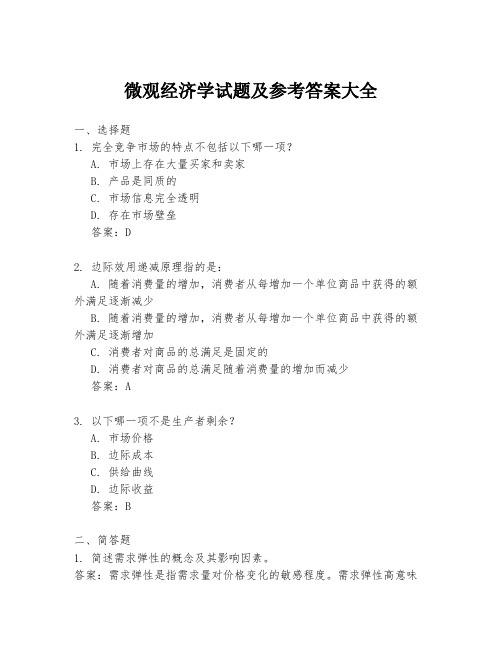
微观经济学试题及参考答案大全一、选择题1. 完全竞争市场的特点不包括以下哪一项?A. 市场上存在大量买家和卖家B. 产品是同质的C. 市场信息完全透明D. 存在市场壁垒答案:D2. 边际效用递减原理指的是:A. 随着消费量的增加,消费者从每增加一个单位商品中获得的额外满足逐渐减少B. 随着消费量的增加,消费者从每增加一个单位商品中获得的额外满足逐渐增加C. 消费者对商品的总满足是固定的D. 消费者对商品的总满足随着消费量的增加而减少答案:A3. 以下哪一项不是生产者剩余?A. 市场价格B. 边际成本C. 供给曲线D. 边际收益答案:B二、简答题1. 简述需求弹性的概念及其影响因素。
答案:需求弹性是指需求量对价格变化的敏感程度。
需求弹性高意味着价格的小幅变动会导致需求量的大幅变动。
影响需求弹性的因素包括商品的替代品数量、商品的必需品程度、消费者的收入水平、商品的用途多样性等。
2. 什么是边际成本和平均成本?它们之间的关系是什么?答案:边际成本是指生产额外一单位产品所增加的总成本。
平均成本是指生产单位产品的平均成本,等于总成本除以生产量。
边际成本与平均成本之间的关系是:当边际成本低于平均成本时,平均成本会下降;当边际成本高于平均成本时,平均成本会上升。
三、计算题1. 假设某公司生产函数为Q = 2L^(1/2)K^(1/3),其中Q是产量,L 是劳动投入,K是资本投入。
如果劳动投入L=4,资本投入K=27,求该公司的产量Q。
答案:将L=4和K=27代入生产函数Q = 2L^(1/2)K^(1/3),得到Q = 2 * (4)^(1/2) * (27)^(1/3) = 2 * 2 * 3 = 12。
2. 假设某商品的市场需求函数为Qd = 100 - 2P,供给函数为Qs = 5P。
求市场均衡价格和数量。
答案:市场均衡时,需求量等于供给量,即Qd = Qs。
将需求函数和供给函数相等,得到100 - 2P = 5P,解得P = 16。
微观经济学试题及答案

微观经济学试题及答案微观经济学题库第一章导论一、选择题1、下列哪一种资源是最不具稀缺的?()A、医生;B、苹果;C、铁矿石;D、经济学课程;E、空气。
2、下列中的哪一个属于规范经济问题?()A、通货膨胀和失业是由什么引起的?B、政府应该雇用所有失业的工人吗?C、消费者如何对较低的价格做出反映?D、收入和储蓄之间的关系是什么? 3、经济学可定义为( )。
A、政府对市场经济的调节B、企业获取报酬的活动C、研究如何最合理地分配稀缺资源及不同的用途D、人们靠工资生活 4、经济学主要是研究( )。
A、与稀缺性和选择有关的问题B、如何在证券市场上盈利C、何时无法作出选择D、用数学方法建立模型 5、“资源是稀缺的”是指( )。
A、世界上大多数人生活在贫困中B、相对于资源的需求而言,资源总是不足的C、资源必须保留给下一代D、世界上的资源最终要被消耗光 6、经济物品是指( )A、有用的物品B、稀缺的物品C、市场上贩卖的物品D、有用且稀缺的物品 7、一国生产可能性曲线以内的一点表示( ) A、供给大于需求 B、失业或者资源未被充分利用 C、该国可利用的资源减少以及技术水平降低 D、资源得到最适度分配使用8、生产可能性曲线说明的基本原理是( )。
A、一国资源总能被充分利用B、假定所有经济资源能得到充分有效利用,则只有减少一种物品的生产才能导致另―种物品生产的增加C、改进技术会引起生产可能性曲线向内移动D、经济能力增长惟一取决于劳动力的数量9、下列各项中哪一项会导致一国生产可能性曲线向外移动()。
A、失业B、通货紧缩C、资源增加或者技术进步D、消费品生产减少,资本品生产下降 10、经济学研究的基本问题是( )。
A、怎样生产B、生产什么,生产多少C、为谁生产D、以上都包括 11、下列命题中哪一个不是实证经济学命题( )。
A、 1982年8月美联储把贴现率降到10% B、1981年失业率超过9%C、联邦所得税对中等收入家庭是不公平的D、社会保险税的课税依据现己超过30000美元 12、微观经济学所要论证的根本思想或目的是 A、一般均衡论 B、“看不见的手”的原理 C、整个资本主义经济可以实现有效率的资源配置 D、完全竞争市场下可以实现帕累托最优二、简答题1、什么是西方经济学?2、试述西方经济学企图解决的两个问题及两重属性。
微观经济学试题库(含答案)
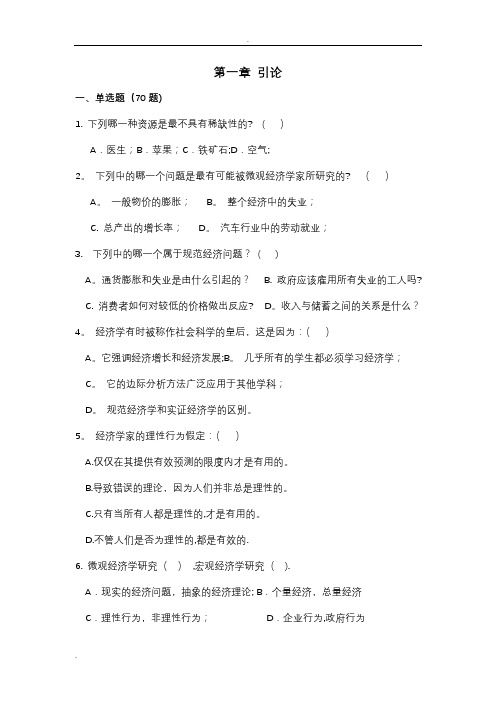
第一章引论一、单选题(70题)1. 下列哪一种资源是最不具有稀缺性的?( )A.医生;B.苹果;C.铁矿石;D.空气;2。
下列中的哪一个问题是最有可能被微观经济学家所研究的?()A。
一般物价的膨胀;B。
整个经济中的失业;C. 总产出的增长率;D。
汽车行业中的劳动就业;3. 下列中的哪一个属于规范经济问题?( )A。
通货膨胀和失业是由什么引起的? B. 政府应该雇用所有失业的工人吗?C. 消费者如何对较低的价格做出反应?D。
收入与储蓄之间的关系是什么?4。
经济学有时被称作社会科学的皇后,这是因为:()A。
它强调经济增长和经济发展;B。
几乎所有的学生都必须学习经济学;C。
它的边际分析方法广泛应用于其他学科;D。
规范经济学和实证经济学的区别。
5。
经济学家的理性行为假定:()A.仅仅在其提供有效预测的限度内才是有用的。
B.导致错误的理论,因为人们并非总是理性的。
C.只有当所有人都是理性的,才是有用的。
D.不管人们是否为理性的,都是有效的.6. 微观经济学研究(),宏观经济学研究().A.现实的经济问题,抽象的经济理论; B.个量经济,总量经济C.理性行为,非理性行为;D.企业行为,政府行为7.经济学可定义为()。
A.政府对市场制度的干预 B.企业赚取利润的活动C.研究稀缺资源如何有效配置的问题D.个人的生财之道8.“资源是稀缺的"是指( )A.资源是不可再生的 B.资源必须留给下一代C。
资源终将被耗费殆尽D。
相对于需求而言,资源总是不足的。
9.失业问题如果反映在生产可能性曲线图上,可记为( )A.生产可能性曲线内的一点 B.生产可能性曲线上的一点C.生产可能性曲线以外的一点D.不在该平面直角坐标系上。
10.下列哪一项会导致一国生产可能性曲线的外移?()A.股市持续走强B。
通货膨胀C.有用资源被发掘或技术进步D.消费品生产增加,资本品生产下降。
11.一个经济体系必须作出的基本选择是()。
A.生产什么,生产多少 B.如何生产C。
(完整版)微观经济学考试试题题库
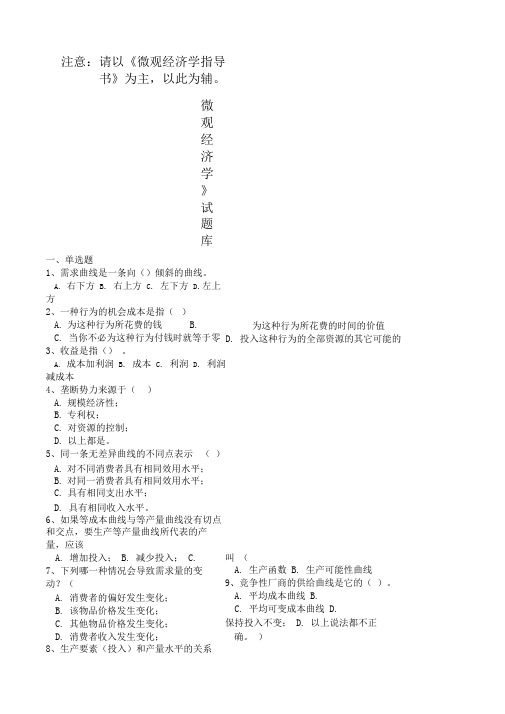
注意:请以《微观经济学指导书》为主,以此为辅。
微观经济学》试题库一、单选题1、需求曲线是一条向()倾斜的曲线。
A.右下方B. 右上方C. 左下方D.左上方2、一种行为的机会成本是指()A.为这种行为所花费的钱B.C. 当你不必为这种行为付钱时就等于零3、收益是指()。
A.成本加利润B. 成本C. 利润D. 利润减成本4、垄断势力来源于()A.规模经济性;B.专利权;C.对资源的控制;D.以上都是。
5、同一条无差异曲线的不同点表示()A.对不同消费者具有相同效用水平;B.对同一消费者具有相同效用水平;C.具有相同支出水平;D. 具有相同收入水平。
6、如果等成本曲线与等产量曲线没有切点和交点,要生产等产量曲线所代表的产量,应该A.增加投入;B. 减少投入;C.7、下列哪一种情况会导致需求量的变动?(A.消费者的偏好发生变化;B.该物品价格发生变化;C.其他物品价格发生变化;D.消费者收入发生变化;8、生产要素(投入)和产量水平的关系叫(A.生产函数B. 生产可能性曲线9、竞争性厂商的供给曲线是它的()。
A.平均成本曲线B.C. 平均可变成本曲线D.保持投入不变; D. 以上说法都不正确。
)为这种行为所花费的时间的价值D. 投入这种行为的全部资源的其它可能的)。
C. 平均成本曲线D. 总成本曲线 平均不变成本曲线 停止生产点以上的边际成本曲线A B C D11、已知物品 X 和 Y 的需求交叉弹性为- 1.2 ,则()。
A. X 和 Y 是正常品;B. X 和 Y 是替代品;10、已知消费可能性线的方程为 2X+5Y=10,则该消费可能性曲线是()C. X 和 Y 是互补品;D. X 和 Y 是劣质品;12、某在职人员准备脱产攻读硕士学位,需花费三年时间,每年需交学费 机会成本为 ( )。
A. 2.4 万元;B. 2.4 万元加三年生活费;C. 因脱产读书而损失的薪金及晋升机会;D. 2.4 万元加三年生活费和薪金及晋升机会损失。
微观经济学试题及答案

微观经济学试题及答案微观经济学试题及答案在平时的学习、工作中,我们最熟悉的就是试题了,试题是命题者根据测试目标和测试事项编写出来的。
什么类型的试题才能有效帮助到我们呢?以下是店铺整理的微观经济学试题及答案,欢迎大家借鉴与参考,希望对大家有所帮助。
微观经济学试题及答案1一、单选题(每题2分,共20分)1、经济学可定义为:( )A、政府对市场制度的干预B、企业取得利润的活动C、研究如何最合理地配置稀缺资源于诸多用途D、人们靠收入生活2、在得出某种商品的个人需求曲线时,下列因素除哪一项外均保持不变( )A、个人收入B、其余商品价格C、个人偏好D、所考虑商品的价格3、保持所有其它因素不变,某种商品的价格下降将导致( )A、失业B、有用性资源增加或技术进步C、通货膨胀D、经济能力增长惟一决定于劳动力数量4、若x和y两产品的交叉弹性是-2.3,则( )A、两者是替代品B、两者是正常品C、两者是劣质品D、两者是互补品5、已知某种商品的市场需求曲线函数为:D=30-P,市场供给函数为:S=3P-10,如果对该商品实行减税,则减税后的市场均衡价格( )A、等于10B、小于10C、大于10D、小于或对于106、无差异曲线的形状取决于( )A、消费者偏好B、消费者收入C、所购商品的价格D、商品效用水平的大小7、消费者剩余是消费者的( )A、实际所得B、主观感受C、没有购买的部分D、消费剩余的部分8、使用自有资金也应计算利息收入,这种利息从成本角度看是( )A、固定成本B、隐含成本C、会计成本D、生产成本9、短期平均成本曲线呈“U”型的原因与( )有关A、规模报酬B、外部经济与不经济C、要素的边际生产D、固定成本与可变成本所占比重10、在一般情况下,厂商得到的价格若低于以下哪种成本就停止营业( )A、平均成本B、平均可变成本C、边际成本D、平均固定成本二、判断是非题(每题1分,共10分)(注:对的打“√”,错的打“×” )1、经济物品是稀缺的物品( )2、经济学是研究怎样优化配置资源的科学( )3、吉芬商品的收入效应大于替代效应( )4、无差异曲线的形状取决于消费者收入( )5、无差异曲线有可能相交( )6、消费者均衡点处于无差异曲线与预算线相切处( )7、劳动的总产量在平均劳动量最大处达到最大( )8、边际收益递减是由于规模报酬递减造成的( )9、经济地租属于长期分析,而准地租属于短期分析( )10、什均衡属于优势策略均衡(占优均衡)( )三、简答题(每题5分,共25分)1、通过生产可能性曲线可以说明哪三个概念?2、影响需求弹性的因素有哪些?3、怎样理解经济学中的机会成本?4、简述劳动供给曲线的形状及形成机理。
微观经济学试题(含答案)

微观经济学试题一、选择题1。
一国的生产可能性曲线上的点表示(D )A、通货膨胀B、失业或者资源没有被充分利用C、该国可利用的资源减少及技术水平降低D、社会使用既定的生产资源所能生产商品的最大组合2。
学校里一块新停车场的机会成本是(B )A、由此引发的所有费用B、由用于其他用途产生的最大价值决定C、由用于建造停车场的机器设备的折旧大小决定D、由在停车场停车所需的费用来决定3.下列有关无差异曲线的特点说法正确的是(D )A、离原点越远,无差异曲线代表的效用水平越小B、同一平面中,两条无差异曲线可能会相交于一点C、无差异曲线向右上方倾斜,并凸向原点D、无差异曲线的斜率为负值4. 如果商品A和B是替代的,则A的价格下降将造成 ( D )A、A的需求曲线向右移动B、A的需求曲线向左移动C、B的需求曲线向右移动D、B的需求曲线向左移动5。
两种商品中若其中的一种价格变化时,这两种商品的购买量同时增加或减少,则这两种商品的交叉价格弹性系数为( A )A、负B、正C、零D、16.市场均衡要求(D )A、政府平衡供求双方的力量B、价格与数量相等C、价格保持不变D、在某一价格水平上,买者想要购买的数量恰好等于卖者想卖的数量7。
当总效用增加时,边际效用应该(B )A、为正值,并其值不断增加B、为正值,并其值不断减少C、为负值,并其值不断减少D、以上任何一种情况都有可能8.当生产函数Q=f(L,K)的APL为递减时,则MPL(D )。
A、递减且为正B、递减且为负C、为零D、上述情况都可能9。
在以下四种情况中,哪一种实现了生产要素的最适组合:( C )A、MPK / PK〈MPL/ PLB、MPK / PK>MPL / PLC、MPK / PK=MPL/ PLD、MPK / PK ≥MPL/ PL10.边际成本低于平均成本时(B ).A、平均成本上升B、平均成本下降C、成本下降D、平均可变成本上升11。
长期边际成本曲线呈U型的原因是(A )。
微观经济学试题及答案

微观经济学一、单项选择题1. 研究家庭和企业决策的经济学称为()。
A.宏观经济学 B.微观经济学C.实证经济学 D.规范经济学2. 社会经济资源的基本特征是()。
A.经济性 B.有用性C.无限性 D.稀缺性3. 下列问题不属于宏观经济学的是()。
A.货币量变动对通货膨胀的影响 B.企业关于雇用多少工人的决策C.高储蓄对经济增长的影响 D.政府管制对汽车废气的影响4. 当胶卷的价格上升时,照相机的需求量将会()。
A.增加B.减少C.不变D.变化不定5. 以下引起需求变动的因素是()。
A.生产要素价格 B. 生产能力水平B.人们的消费偏好 D. 商品价格水平6. 当茶叶的价格上升时,咖啡的需求量将会()。
A. 增加B. 减少C.不变D.变化不定7. 边际效用是指()。
A. 增加单位商品的消费而增加的平均效用量B. 增加单位商品的消费而增加的总效用量C. 增加单位商品的消费而减少的平均效用量D. 增加单位商品的消费而减少的总效用量8. 一般来说,当消费者沿着同一条无差异曲线增加X物品(用横线代表)的消费量()。
A.每增加1单位X物品就要放弃更多的Y物品B.每增加1单位X物品就要放弃更少的Y物品C.边际替代率递减D.b与c都对9. 第四张比萨饼带来的满足不如第三张比萨饼这一事实是下列哪一个概念的例子。
()A. 消费者剩余B. 总效用递减C. 边际效用递减D. 价值之谜10. 边际报酬递减规律研究的问题是()。
A. 各种生产要素同时变动对产量的影响B. 不同生产要素变动对产量的影响C. 特殊生产要素变动对产量的影响D. 其他生产要素不变,一种生产要素变动对产量的影响11. 在其他生产要素不变的条件下,平均产量曲线与边际产量曲线的交点代表()。
A.总产量达到最大 B. 要素产出效率最高C. 边际产量为零D. 边际产量达到最大12. 劳动对资本的边际替代率衡量()。
A.在保持产量不变时,劳动量增加1单位资本量增加多少B.在保持产量不变时,劳动量增加1单位资本量减少多少C.相对于资本价格的劳动价格D.等成本线的斜率13. 已知产量为100单位时间,总成本为9500元,当产量增加到110单位时,总成本为10000元。
- 1、下载文档前请自行甄别文档内容的完整性,平台不提供额外的编辑、内容补充、找答案等附加服务。
- 2、"仅部分预览"的文档,不可在线预览部分如存在完整性等问题,可反馈申请退款(可完整预览的文档不适用该条件!)。
- 3、如文档侵犯您的权益,请联系客服反馈,我们会尽快为您处理(人工客服工作时间:9:00-18:30)。
Pro¯t Maximization by a Competitive FirmHaving derived the total cost function(either long run or short run),we can now solve for the pro¯t-maximizing output level,x¤.Given x¤,we can then compute the unconditional demand for inputs such ascapital and labor.The pro¯t function is total revenue minus total cost,¼(x)=T R(x)¡T C(x):For an interior choice of x that maximizes pro¯t,set the derivative equal to zero:d¼(x) dx =dT R(x)dx¡dT C(x)dx=MR(x)¡MC(x)=0:Thus,a pro¯t maximizing¯rm(either competitive or one with market power)chooses x so that marginal revenue equals marginal cost.A perfectly competitive¯rm cannot in°uence the price, p x.Therefore,marginal revenue is just the price, since one more unit receives additional revenues of p x.A perfectly competitive¯rm's pro¯t function is then ¼(x)=p x x¡T C(x);and the condition for(interior) pro¯t maximization isp x=MC(x):(1)To make sure that we have a pro¯t maximum(and not a minimum!),use the second-order conditiond2¼dx =¡dMC(x)dx<0;which says that the marginal cost curve should be upward sloping(increasing in x).The interpretation of equation(1),p x=MC(x),is not that the¯rm is choosing the price.Rather,the¯rm takes the price as determined in the market,and chooses x at the point where marginal cost equals the price.Perfect competition assumes that the¯rm has no mar-ket power to in°uence the price it can charge.All ¯rms in the market for good x produce the exact same product,and all consumers know about all the¯rms and what they are charging.A¯rm can sell as much as it wants at the market price.No explanation for Marketing Departments.We can think of the¯rm as free to choose its price,but if it charges a penny above p x it loses all its customers. There is no reason to charge less,either,since you can sell all you want at p x:This idealization should shed light on actual markets that are fairly competitive.At any price,the ¯rm will choose x so that p x =MC (x ):Thus,a competitive ¯rm's marginal cost curve is its supply curve.The Short Run Supply Curve00.511.522.53$/unit xCompetitive Firm's Short Run Supply CurveIf p x is greater than the minimum SRATC,the¯rm re-ceives positive economic pro¯ts by selecting the pro¯t maximizing x.If p x is greater than the minimum SRA VC but less than the minimum SRATC,the¯rm receives negative pro¯ts,but still should produce.If p x is less than the minimum SRA VC,the¯rm cannot even cover its variable costs at any level of output,and should shut down.To see this,pro¯ts from producing x are:p x x¡SRV C¡F C:Pro¯ts from producing zero are:¡F C.Therefore,shut down if,for all x,p x x¡SRV C<0, or p x<SRV C=x=SRAV C:Notice that the decision of what to produce,and whether to shut down,does not depend on the level of¯xed costs.Movies:(1)losing your tickets(2)whether to walk out.Sunk costs vs.¯xed costs:Sunk costs cannot be re-covered,and are totally irrelevent to any pro¯t maxi-mizing decision.All¯xed costs are sunk in the short run,but some¯xed costs may not be sunk in the long run.For example,an airline may have the size of its°eet ¯xed in the short run,but much of the cost can be recovered by selling the planes.In the short run,the ¯xed cost of the planes is irrelevant to the decision of how many°ights to o®er,or whether to temporarily shut down.In the long run,the¯rm has the option of adjusting its°eet by selling planes,so these costs (¯xed in the short run but not sunk)can matter.A quasi-¯xed cost arises when a¯rm does not pur-chase any of the input when output is zero,but pur-chases a¯xed quantity of the input for any positive output.For example,a bar must purchase a liquor licence no matter how many drinks it plans to serve, but it can avoid this cost if it shuts down before pur-chasing the licence.Importance of marginal cost,practical issues:isolate only those costs that depend on output(1)separate depreciation that depends on time from depreciation that depends on output(2)separate¯xed overhead costs from overhead costs that depend on output(3)costs that depend on today's output but arise later should be charged to today(delayed maintenance and repairs)Complete solution of the ¯rm's problem in the short run :an examplef (K;L )=K 1=2L 1=2,where K is ¯xed at K .Approach #1:choose L to maximize pro¯ts.¼=p x K 1=2L 1=2¡wL ¡rKThe ¯rst order condition is @¼@L =0=12p x K 1=2L ¡1=2¡w:Solving for L,we haveL ¡1=2=2wp x K1:Taking both sides to the ¡2power,we haveL ¤=p 2x K4w 2:(2)Plugging(2)into the production function,we have the optimal output choice:x=K1=2L1=2=K=2(p2x K4w2)1=2=Kp x2w:This gives us the equation for the supply curve,where x depends only on K and prices.The¯rm's pro¯ts will be¼=p x(Kp x2w)¡w(p2x K4w2)¡rK:Approach#2:Set SRMC equal to the price. From x=K1=2L1=2;we solve for L:L1=2=xK1,which implies L=x2K:Therefore,we haveSRT C=w x2K+rK:Taking the derivative to get SRMC,and setting it equal to the price,we haveSRMC=2wxK=p x:Notice that SRAV C=wx=K;so the minimum SRA VC occurs at x=0.We do not have to worry about shut-ting down.Changes in the Supply Curve{We move along the supply curve(in x¡p x space) when we change p x.At higher prices,the quantity supplied increases.{The supply curve shifts when we change the price of variable inputs.Here,an increase in w increases marginal cost and shifts the supply curve up and steeper, so less output is supplied at any price.{The supply curve depends on K.Higher K lowers marginal cost and shifts the supply curve down and °atter,so more output is supplied at any price.{Technological change can shift the supply curve,usu-ally leading to more output at any price.。
